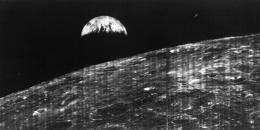Solar wind, moon dust and Martian lights

The Canadian Space Agency has funded a University of Alberta-led project to study the effects of solar winds on Earth’s moon and on Mars. The results are anticipated to influence design of spacecraft for robotic and human exploration.
“We have limited data regarding the environments in which equipment and astronauts must function and how these environments respond to solar activity,” says Clare Watt, a research associate with the project. “There is small room for error in these high-cost missions, especially when there are lives at stake.”
The Cluster for Lunar and Planetary Sciences project is a multiple-university undertaking led by Department of �鶹��Ժics professor Robert Rankin. The three-year, $450,000 award is split evenly between the University of Alberta and the University of Waterloo. The University of Toronto also has a piece, and the University of Calgary is part of the group in an advisory capacity.
“Researchers will combine state-of-the-art simulation models of our solar system in order to study the solar wind and its interaction with rocky planetary surfaces such as our moon and Mars,” says Watt. She adds that the Clusters project also allows for collaboration between scientists who study the atmosphere around planetary bodies and scientists who study the surfaces.
Watt leads a part of the project that looks specifically at the effect of solar winds on the moon. For example, solar winds intensify the static electric charge of dust storms on the moon. “You don’t want to land in one,” she says. “Lunar dust is not like the dust we have here on Earth. It’s very fine and difficult to shield against. It’s electrically charged, so it’s attracted to the metal [on landing craft and the electronics in them] and could create short circuits.”
Another University of Alberta group, led by professor Ian Mann, will concentrate on Martian aurorae. Discovered in 2005, aurora activity on Mars is little understood. Watt says, “Martian aurorae can provide key information about how the solar wind interacts with the Martian surface, and will provide valuable insight into how the atmosphere and surface have been eroded through thousands of years of solar wind weathering.”
Besides the possible technological applications, the Clusters project will allow students to hone computer modelling skills using recent exploratory data from NASA and the European Space Agency. Students working with mature software that simulates the larger scale will be customizing it in light of new data. Students working on the smaller scale—the “up close” data from Mars and our moon—will be building new simulation models from scratch.
“There are a lot of new skills involved,” says Watt. “They will have to be creative to envision the environments on the moon and on Mars.”
Provided by University of Alberta





















